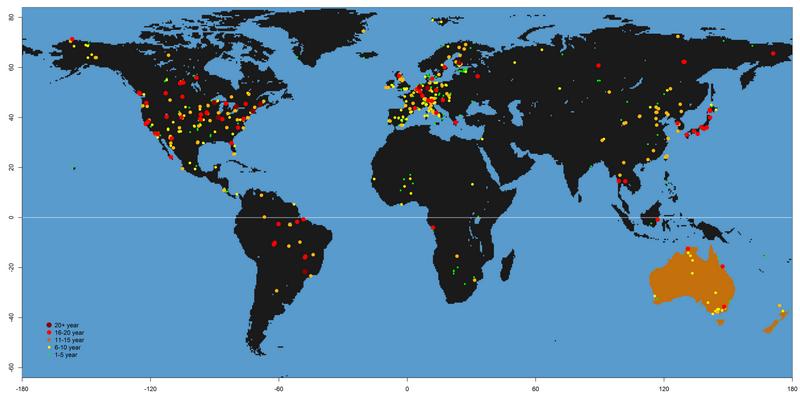An international network of high-tech flux measuring towers enables us to watch continents breathe in and out, every hour, every day, over all seasons and across the changing years. This global flux-measuring network, called FluxNet, has over 700 sites and the Australian component, OzFlux, has about 30 landscape observatory sites.
Data from 28 of the 30 OzFlux sites are now openly accessible via FluxNet. OzFlux datasets are internationally recognised as being of a very high quality and containing very few data gaps and errors—as measured by the data’s energy balance closure.
Good quality data and easy collaboration with the OzFlux network through its data manager Peter Isaac make OzFlux a preferred partner in collaborations with FluxNet but also other international organisations, including with NASA who use OzFlux data to link water, energy and carbon cycles with their SMAP (soil moisture active passive) mission.
The new FluxNet access arrangements are making it easier for researchers all over the world to access and download Australian flux data. For example, data from the Tumbarumba flux station—one of the few southern hemisphere sites that has provided records for longer than a decade—has been downloaded over 100 times since becoming available via the FluxNet site in January 2016.
The global flux measuring network, FluxNet, has over 700 sites and the Australian component, TERN OzFlux, has about 30 sites. Data on the exchanges of heat, water and carbon dioxide between terrestrial ecosystems and the atmosphere collected by OzFlux are now openly-accessible via FluxNet. (Graphics by Housen Chu, UCB Data sources (FLUXNET, ICOS, AmeriFlux & Fluxdata.org), accessed in June, 2015).
Tumbarumba site manager and Director of TERN’s OzFlux facility, Dr Eva van Gorsel of CSIRO, says that the number of people accessing the data from outside Australia has increased since the new access arrangement.
“Tumbarumba flux data have been downloaded by researchers all over the world,” says Eva. “I’ve received notice of downloads from the USA, including from NASA, all over Europe, including Germany, Switzerland, Sweden, Norway, Belgium and Italy, and from China and Japan in Asia. It’s fantastic to see that people are accessing the data and it’s even more exciting to think of the new science that’s being done with it.”
Scientists’ analysis of the data improves our understanding of the response of ecosystems to climate variability, disturbance (including fire, droughts, insects), land management and current and future changes in precipitation, temperature and carbon dioxide levels.
“When people download the data from Tumbarumba they give a brief description of the data’s intended use,” says Eva. “I was really happy to see such a diverse list of data applications.”
“Studies include work on spatial and temporal variation of the carbon exchange and water use. A lot of work focuses on the functional relationships between environmental drivers and fluxes and ecosystem responses to a changing climate and extreme events such as heat waves. A large body of work is used to improve remotely-sensed products and for model development, testing and benchmarking.”
“But it’s not only pure research that these data are facilitating. People are using the data for educational purposes in teaching science and data analysis—a really fantastic outcome,” recalls Eva.
The application of data from Tumbarumba is just one of the many examples of how the networks and data being delivered through TERN’s OzFlux facility are being increasingly frequently used in diverse multidisciplinary research contexts. OzFlux infrastructure continues to catalyse advances in our knowledge of the land-air exchanges of carbon and water across a range of ecosystems and meteorological conditions.
- The Tumbarumba flux station is supported by TERN, CSIRO and the Department of Climate Change and Energy Efficiency (DCCEE) through the Australian Climate Change Science Program (ACCSP).
Published in TERN newsletter April 2016








